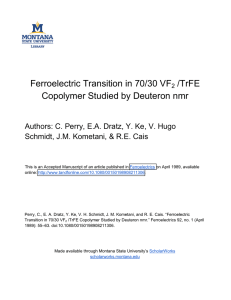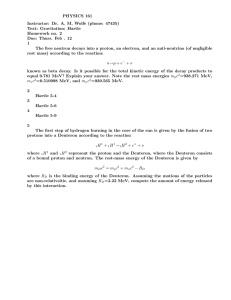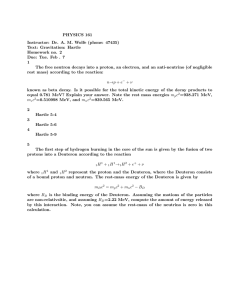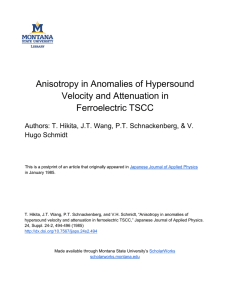Deuteron NMR Study of Ferroelectric Transition in VF /TrFE Copolymer
advertisement
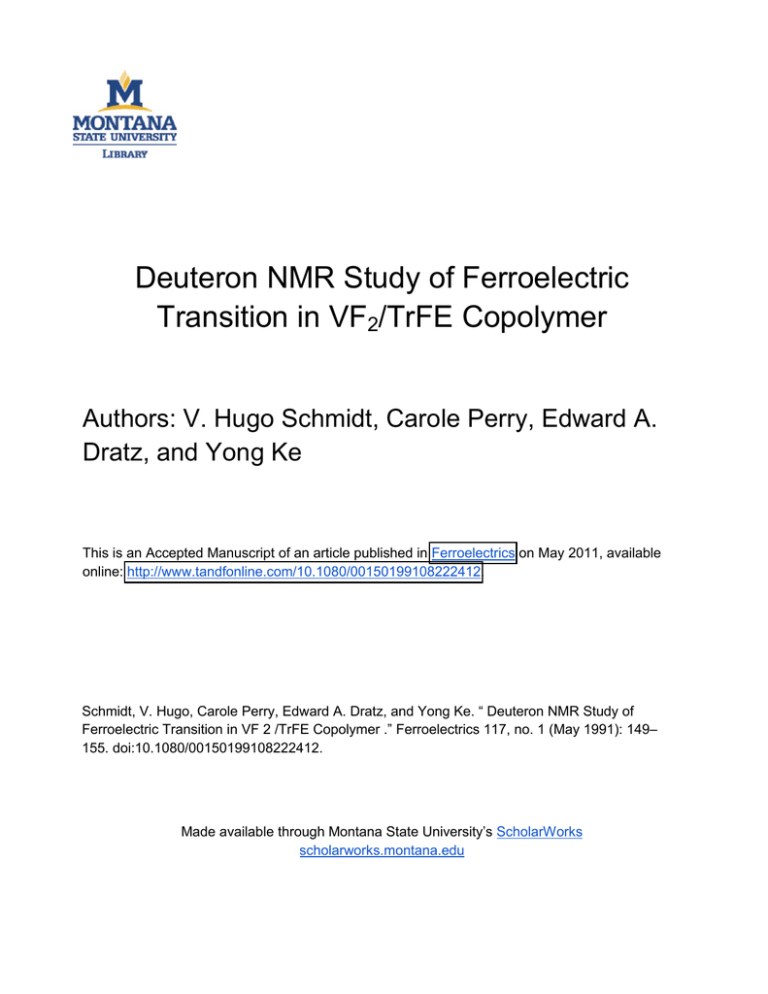
Deuteron NMR Study of Ferroelectric Transition in VF2/TrFE Copolymer Authors: V. Hugo Schmidt, Carole Perry, Edward A. Dratz, and Yong Ke This is an Accepted Manuscript of an article published in Ferroelectrics on May 2011, available online: http://www.tandfonline.com/10.1080/00150199108222412. Schmidt, V. Hugo, Carole Perry, Edward A. Dratz, and Yong Ke. “ Deuteron NMR Study of Ferroelectric Transition in VF 2 /TrFE Copolymer .” Ferroelectrics 117, no. 1 (May 1991): 149– 155. doi:10.1080/00150199108222412. Made available through Montana State University’s ScholarWorks scholarworks.montana.edu Ferroelecrrics, 1991, Vol. 117, pp. 149-155 Reprints available directly from the publisher Photocopying permitted by license only DEUTERON NMR COPOLYMER STUDY OF 0 1991 Gordon and Breach Science Publishers S.A. Printed in the United States of America FERROELECTRIC TRANSITION V. HUGO SCHMIDT’, CAROLE PERRYZ, EDWARD A. DRATZ’, Montana State University, Bozeman, MT 59717 ‘Department of Physics ZDepartment of Chemistry IN VFz/TrFE and YONG KE1 (Received July 24, 1989; in final form October 16, 1989) abstract - Deuteron NMR results on a 70/30 mole Ri random copolymer of deuterated vinylidene fluoride and normal trifluoroethylene are reviewed, for temperatures on both sides of the ferroelectric-paraelectric phase transition of the crystalline portion of the copolymer. A calculation is presented for the deuteron quadrupolar NMR spin-lattice relaxation caused by kink-+bond motions along disordered helical chains in the paraelectric phase. Poly (vinylidene fluoride) , formula (CHZ CFZ )B , abbreviated PVFn, is a polymer which exhibits a strong and commercially important piezoelectric effect.’-3 The crystals formed from the melt are in the antiferroelectric a phase, and the polymer must be stretched and poled to convert these crystals to the piezoelectric and ferroelectric $ phase. The $ phase has a trans configuration of the C-C- chains, with protons on one side and fluorines on the other. This arrangement provides a large spontaneous polarization which is significantly altered by stress and which can be reversed by a strong electric field. Therefore it is piezoelectric and ferroelectric. It exhibits no transition to a nonferroelectric state because it melts near 180 OC before such a state is reached. Polytrifluoroethylene (PTrFE), formula (CHFCFzI S , has a structure which is still controversial. Kolda and Land04 proposed a 3/1 helix with a pitch distance 6.75 Ao. Later, Tashiro et a1.O claimed it has a trans configuration, although their phase diagram shows above 50 OC a “gauche” phase described (for their 55/45 VFz/TrFE copolymer) as a mixture of T3G, TG, TaG*, and TG* sequences with average fiber period 4.60 A o . Both the 3/1 helix.and the gauche structures are not piezoelectric. When random copolymers of VFZ and TrFE are made, the TrFE imparts desirable properties to the copolymer. First, the copolymer with over 15 mole Ri TrFE crystallizes into the $ phase directly,e-a without stretching, so only poling is needed to make it macroscopically piezoelectric. Second, a higher degree of crystallinity can be obtained,9 and it is the crystalline portion which is piezoelectric. Third, the ferroelectric transition is accessible for study because it falls below the melting point for over 15 mole Ri TrFE.10 The structure of the high-temperature (paraelectric) 149 phase of 150 V. H. SCHMIDT et al. these copolymers is believed to be disordered hexagonal, thereby showing some similarity to the hexagonal structure of pure PTrFE Studies of the ferroelectric-paraelectric (FE-PE) polymer transition by various experimental methods show that the transition occurs over a wide temperature range and also exhibits a large thermal hysteresis. . A number of nuclear magnetic resonance (NMR) studies have been made of PVFZ and its copolymers." Most of these measurements have been made on the abundant spin l/2 nuclei in these However, nuclei with quadrupole materials, namely 1H and 19F. moments (such as the deuteron, 2H or D, spin 1) yield much structural and dynamic information which is difficult to obtain with spin 1/2 nuclei. For this reason we performed a deuteron NMR study12 of a 70/30 mole % random copolymer of fully deuterated VFZ (CDZCFz monomer) and ordinary TrFE (CHFCFz monomer). This work complemented 1H and 19F NMR studies on the undeuterated 70/30 copolymer made by uss and by Hirschinger, Meurer, and Weill.8 The deuterated sample was prepared by Janet Kometani and R. E. Cais at ATT-Bell Labs at Murray Hill. We used a Chemagnetics NMR system operating at a deuteron resonant frequency of about 30 MHz, with 90° pulse time of 2.8 microseconds. We used a 90x-9Oy quadrupolar echo technique to find the spectra and spin-spin relaxation time Te. We employed a sequence of such pulse pairs to find the spin-lattice relaxation time TI. Unfortunately, the software limited the pulse pair repetition time to 90 milliseconds or longer. At 90 msec separation no saturation could be observed for the paraelectric phase signal, so we were unable to determine T I , other than to note that it must be shorter than about 30 milliseconds. The most striking feature of our results was that, while the ferroelectric crystalline phase showed a static "Pake doublet" powder pattern, the paraelectric crystalline phase showed a pattern of similar shape but 1/3 as wide. This was interpreted as resulting from motional narrowing caused by C-D bonds making tetrahedral angles with the chain axis at all times, but rotating about that axis so as to average the electric field gradient tensor components perpendicular to the chain axis. The structure most likely to give such a spectrum is a disordered helical chain, with kink-3-bond defects13 running up and down the chain and thereby rotating the C-D bonds by 1200 steps about the chain. To study the dynamics of the paraelectric phase, we are making deuteron TI measurements in that phase and will compare these results with predictions of an analytic model presented below. We plan to make Monte Carlo simulations of the chain dynamics to look for deviations from this simple dynamic model. For a model of the polymer chain in the paraelectric phase, we believe as discussed above that there are short helical chain DEUTERON NMR STUDY OF FERROELECTRIC TRANSITION IN VF,/TrFE COPOLYMER 151 segments connected by mobile kink-3-bond defects. As illustrated in Fig. 1, the defect can move to a new location, thereby shortening one (say clockwise) chain segment by one turn and lengthening an adjacent (counterclockwise) segment by one turn. At the boundary, according to the chain-axis projection in Pig. 1, the chain center would move from the center of one equilateral triangle to an adjacent triangle. Because of the constraints of neighboring chains, the chain axis would relax in one or two lattice spaces back to the average position midway between the two triangle centers. These constraints make it unlikely that two kinks will get so close together that in the projection shown in Fig. 1, two adjacent bond projections will lie along the same line. The chain conformation rule then becomes: at every vertex of the chain projection, the chain must either turn through 1200 and continue its previous helix, or it must turn through 1200 in the opposite sense and begin a new helix wound in the opposite sense. The statistical analysis of the chain static conformation subject to the above rule is quite simple. Each C-C bond having a nonzero projection component in Fig. 1 (in other words, every other C-C bond) can either be in the interior of a helix at zero energy, or can be the boundary between a clockwise and counterclockwise segment at positive creation energy E ~ . Then each such bond has probability [l+exp($Ec 1 1 - l of constituting a boundary, where B=l/kT. The dynamic behavior is more complex. A boundary moves by 3 projected bonds (six C-C bonds) during one kink-3-bond displacement, but can only do this if there are no intervening boundaries. If there are two boundaries 3 projected bonds (one turn) apart, they can annihilate and liberate energy 2 a ~ . In helix segments long enough to contain four or more zero-energy adjacent projected bonds, it is possible to create a new segment inside this segment of length one turn, at a cost of energy 2 e c . Because there is considerable distortion involved in moving a kink-3-bond defect one step along a chain, we assume that such motion requires surmounting a diffusion barrier of height t d . with attempt frequency fo. The analysis becomes simpler if we assume BE^>>^ and $ E d > > l . Then the fraction of boundary-type projected bonds is exp(-$rc), twice that fraction of C-D bonds reorient by a projected angle of 1200 if all these boundaries move one helix turn, and the Thus probability of such motion per unit time is foexp(-f3ed) the probability w per unit time that a given C-D bond reorients in a given direction is . w=fo exp [-B ( cc + a d 13 . (1) The above expression for w is the starting point of our analysis for spin-lattice relaxation time in the paraelectric phase. The important type of average needed in this calculation is <V(O)V(t)>,where V represents a component (subscripts omitted 152 V. H. SCHMIDT et al. projection along helical chain axis of kink-3-bond motion, which can: 1) Move cw-ccw boundary up or down 1 turn, as shown; 2) Create or destroy pair of boundaries; 3) Average *D efg components perpendicular to chain. Figure 1 DEUTERON NMR STUDY OF FERROELECTRIC TRANSITION IN VF,/TrFE COPOLYMER 153 here) of the electric field gradient (efg) tensor at a typical deuteron site. A given deuteron is assumed to spend equal time at three sites at which V-VI, VZ, and V3. For finding TI we need only consider deviations from the time-averaged value of V, SO zvi =o. To find the autocorrelation function for V, we consider the three differential equations for the probability PI (V1.t) that V has the value Vi at time t. These three equations are dPi /dt=-2wPi +W (Pz+P3 1 (2) PI (t)=[l+2exp(-3wt)l/3, PZ (t)=P3 (t)=[l-exp(-3wt)1/3. (3) <V(O)v(t)>=(l/3)VtP1( O ) W I P I(t)+(2 corresponding terms) (4) and two similar equations formed by cyclic permutation of the subscripts. For boundary conditions VI (0)=1, VZ (o)=v3 ( O ) = O the solutions are We use these solutions, and two others obtained for the cases Pz(0)=1 and P3 (0)=1 by cyclic permutation of subscripts in Eq. (3), to evaluate the autocorrelation function: = (2/9)(ViZ+VZ2 +V3 2 -VIVZ -VZV3 -V3 Vl exp (-3wt =(2/3) [ (VI+Vz) z - V ~ V ~ ] e ~ p ( - 3 ~ t ) . The last expression is obtained by substituting V3=-Vi-Vz. To find the efg tensor components in a reference frame in which Vzr is along the static magnetic field H o , as required for quadrupole-perturbed NMR, we assume the efg is axially symmetric ( q = O ) with its principal axis along the C-D bond which is assumed to make the tetrahedral angle (cosa=-1/3) with the chain axis. If HO is along this bond axis, eQVzz/h (the quadrupolar coupling constant) is 156.7 kHz, which for the 1=1 deuteron is 2/3 of the maximum splitting 235.1 kHz of the resonance lines for the deuteron powder pattern. Here e is proton charge, Q is deuteron electric quadrupole moment, and h is Planck's constant. For arbitrary HO direction, it is necessary to rotate the coordinate system from z along the bond axis through the Next the tetrahedral angle so that z is along the chain axis. coordinate system must be rotated about the chain axis until the y axis lies along the projection of HO onto a plane perpendicular to the chain axis. Finally the z axis must be rotated until it is along Ho. The efg tensor, which starts in a simple diagonal representation, must be transformed by these rotations until it is in the HO frame. If 8 is the polar angle of HO relative to the chain axis, and 0 is the angle between the projections of Ho and the bond onto a plane perpendicular to the chain axis, the efg components (less their average values) in the HO frame are 154 vx x vy V. H . SCHMIDT et al. =- ( 2/ 3 cos 20, (5) = (1/3) (l+cos201cos20- (211 2 /3)sin2eeos0, Vz z = (1/3)(l-cos28)cos20+ (211 2 /3)sin2eeos0, Vw = (2/3)cosesin20 (211 2 /3)sin0sin0, V& =-(2/3)sinesin20 (21/2/3)cosesinB, Vyz=-(1/3)sin20eos20 ~ ( 2 1 / ~ / 3 ) c o s 2 0 e o s 0 . For 1=1 nuclei in the fast motion regime, the spin-lattice relaxation due to efg fluctuations is ~/TI=(II~/ (eQ/h)z ~ W ) ( V P ~ + V ~ Z + ( V X . - V , Y ) ~ + ~I V. ~ Y Here Vtz, for instance, signifies the square bracket expression of Eq. (4), namely (6) in the last vz.=~vx, (e,?a)+vxz(e,0+1200 )12-vXz (e,.O)vxz (e,.0+1200). (7) For a powder sample like ours, Eq. (6) should be averaged over solid angle to account for the various orientations of the For symmetry reasons, the crystal axes relative to Ho. integration over 0 need be carried out only from 00 to 6 0 0 . We have not yet performed this integration, but for a rough idea of its value, we evaluate TI at the middle of the integration range, namely 8=90°, 0 ~ 3 0 0 . We obtain w=5. 68x1010T1/sec2 . (8) So far, we only know that TI <30 msec, so if in Eq. (1) we assume f o = k b / h , and assume Debye temperature 00 of 300 K, then at our highest temperature of measurement, 140 OC, we have a lower limit on the activation energy sum of (Ec +Ed ) /k>3390 K. Measurements of in progress. (9) the deuteron This work was supported in part NO. DE-FG06-87ER45292. REFERENCES TI in the paraelectric phase are by Department of Energy Grant 1. R. G. Kepler and R. A. Anderson, CRC Critical Reviews in Solid State and Materials Science, Nov. 1980, p. 399. 2. M. A. Marcus, Ferroelectrics 40, 29 (1982). 3. A. J. Lovinger, in 'Developments in Crystalline Polymers', (Ed. D.C. Bassett), Applied Science, London, 1981, p. 195. DEUTERON NMR STUDY OF FERROELECTRIC TRANSITION IN VF,/TrFE COPOLYMER 155 4. R. R. Kolda and J. B. Lando, J. Macromol. Sci. 5. K. Tashiro, K. Takano, M. Kobayashi, Y. Chatani, and H. Tadokoro, Ferroelectrics 297 (1984). 6. A. J. Lovinger, T. Furukawa, G. T. Davis, and M. Broadhurst, Polymer 2 4 , 1225 (1983). 209 7. T. Yagi, M. Tatemoto, and J. I. Sako, Polym. J. 3.2, (1980). 8. J. Hirschinger, B. Meurer, and G. Weill, Polymer 2 8 , 721 (1987). 9. J. F. Legrand, P. J. Schuele, V. H. Schmidt, and M. Minier, Polymer 26, 1683 (1985). 10. T. Yamada and T. J. Kitayama, Appl. Phys. 5 2 , 6859 (1981). 11. V. H. Schmidt, Ferroelectrics 7 3 , 333 (1987). 12. C. Perry, E. A. Dratz, Y. Ke, V. H. Schmidt, J. M. Kometani, and R. E. Cais, to appear in Ferroelectrics. 13. H. W. Spiess, Colloid and Polym. Sci. 193 (1983). z, a,
